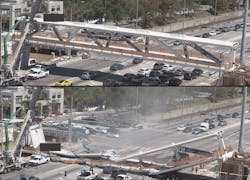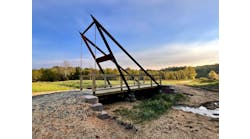The National Transportation Safety Board (NTSB) recently released its final report on the Florida International University (FIU) pedestrian bridge collapse that took place in March 2018.
The report reiterates what the NTSB already announced in a recent public meeting about the determined cause of the bridge's collapse, along with safety recommendations from the agency to the Federal Highway Administration (FHWA), the Florida DOT (FDOT), the American Association of State Highway and Transportation Officials (AASHTO), and FIGG Bridge Engineers Inc. (the designer of the bridge).
The NTSB says its investigation focused on the following safety issues: bridge design and construction plan errors, and unique bridge characteristics and mechanisms of failure; independent peer review of complex bridge design; shortcomings in oversight of evaluation of and response to significant observed bridge structure distress prior to collapse; and lack of redundancy guidelines in specifications for pedestrian and concrete truss bridges.
The agency had announced at its meeting that the probable cause of the collapse was the load and capacity calculation errors made by FIGG in its design of the main span truss member 11/12 nodal region and connection to the bridge deck. In addition, the agency determined that inadequate peer review by Louis Berger contributed to the collapse. The report also says the severity of the collapse—which led to the deaths of six people—was due to the failure of multiple contractors and agencies—including FDOT—to cease bridge work when cracking in the structure had reached "unacceptable" levels and to take appropriate action to close down SW 8th Street in order to protect the public.
Towards the end of the final report, the NTSB makes several safety recommendations, most of which were for FDOT. This included the recommendation that FDOT revise its Plans Preparation Manual to require that the qualified independent peer review for category 2 bridge structures include checking and verifying the design calculations used for all nodal forces. It also recommended procedural implementations to specify that when structural cracks are initially detected during bridge construction, that the parties responsible for the bridge work immediately close the bridge to construction personnel and close the roadway underneath it as well as restrict pedestrian and vehicular traffic on the bridge itself.
In a concurring statement regarding the findings of the investigation, NTSB Vice Chairman Bruce Landsberg noted that this event would serve as a landmark case study for years with engineering schools. "The bridge was not properly designed, and there was no qualified oversight on that design," Landsberg said in his statement. "Once the cracking became evident, not one of the organizations involved was willing to take the essential and unpopular step to call a halt and close the road."
The entire report, including Landsberg's statement, can be viewed on the NTSB website.
------
SOURCE: NTSB



